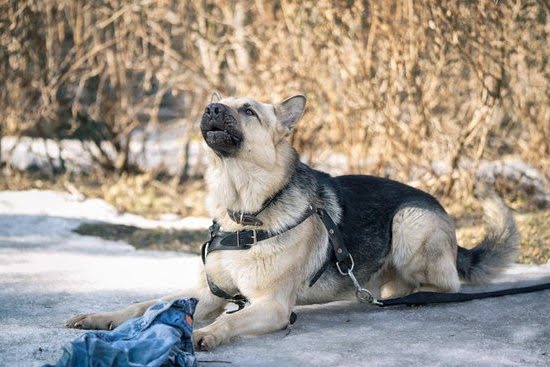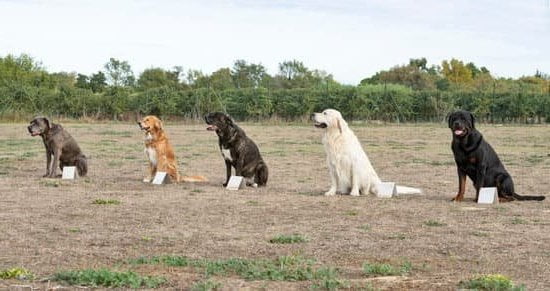Introduction
Training your dog not to bark can be incredibly beneficial for both you and your pet. It can bring peace and quiet to your home since excessive barking can be disruptive for neighbors, family members, and other pets in the household. It teaches your pet how to focus better, creates a stronger bond between you two, and reinforces desirable behavior. Ultimately, training your dog not to bark will lead to a happier and healthier lifestyle for the both of you.
Identifying Different Types of Barking
1) Territorial/Defensive barking – This type of barking happens when the dog feels threatened, or is trying to protect its territory. This can be due to an unfamiliar noise, approach, or sight of a stranger. Visual cue example: A person is coming towards your, and your dog starts barking in defense because they do not know who this person is yet. Approach: Allow the stranger to stand still & remove your own body language cues so that the dog does not think you are giving them permission to bark; this will show them that it’s not necessary for them to bark any longer.
2) Attention Seeking/Excitable barking – This type of barking usually happens when a dog wants attention from their owner, usually in the form of wanting to play. Visual cue example: Your dog has noticed you paying attention to something other than them and begins barking in order to get you attention back on them. Approach: If possible provide your pet with alternate ways of getting your attention- such as using toys or teaching them commands like “Sit” or “Down” so they can gain the desired attention instead of seeking it through excessive barking.
3) Frustration/Boredom Barking – Dogs often find themselves feeling frustrated and even bored at times, which can result in an excessive amount of loud vocalizing in the form of barking. Visual cue example: Your pup has been inside all day and seems overwhelmed with boredom- they start pacing around and barking out loud as if they’re trying express how frustrated they feel being cooped up all day long. Approach: Make sure your pup is getting enough physical exercise throughout the day, as well as mentally stimulating activities like puzzles; this will give them something else to focus on rather than just boredom and allow for more control over any outbursts of frustration-related vocalizing.
Understanding The Causes Of Barking
Barking is a normal behavior for dogs, and in some cases it is even necessary. For example, barking can be helpful when a dog needs to alert their owners of potential danger or when a dog is startled by an unknown noise.
However, excessive barking can become very annoying and detract from the quality of life for both you and your pet. When looking to better control your puppy’s barking habits, first it’s important to understand why they are doing it so you can identify the trigger – this will help you address the issue more effectively.
Common causes of barking include excitement or playfulness, fear/anxiety, territorial behavior, boredom or hunger. If a dog is excited or playing, their bark will be high-pitched and their body language may show signs such as jumping up while they are barking. Fear/anxiety may cause them to bark more urgently than usual and with an intense tone; sometimes they may begin panting heavily if the fear becomes too much for them to cope with. Territorial behavior is usually characterized by low pitched and loud barks for prolonged periods of time; often accompanied by aggressive body language such as growling or posturing. If a pup barks out of boredom or hunger then there is usually little emotion behind their vocalization – it will sound almost robotic in its lack of enthusiasm! Of course no two barks are the same so it’s important to look closely at what type of context your pup is in when they bark so you can interpret what the underlying reason might be behind it all.
Creating A Barking Control Plan
Creating a barking control plan is critical to teaching your dog not to bark. Positive reinforcement techniques should be used, such as rewarding your pup for not barking when they exhibit the desired behavior or providing them with a distraction when they become vocal. Before implementing the plan, it is important to identify what triggers your pup to bark. Once identified, refer to the following steps:
1. Reward desired behaviors – For example, reward your pup with treats and praise whenever he is quiet and withhold all rewards when he barks. Maintaining consistency in reward methods will further reinforce patience and calmness from him.
2. Utilize distractions – Provide alternative activities that require the pup’s focus in order to divert that energy towards something else; for instance, Kong toys are great for occupying their attention away from barking at outsiders passing by or at other dogs on walks.
3. Minimize access – Restricting access to anything that prompts your pup to bark is a good way to desensitize him over time; block up windows or restrict roaming outdoors until training is completed.
4. Exercise often – Dogs left alone without adequate exercise may reach out by barking – take them out on regular walks throughout the day so he gets tired and is better able to relax afterwards .
Following this plan closely over several weeks helps condition the dog’s behavior so eventually it will become natural for them not to bark over time. Be sure practice these steps frequently using consistent motivation methods and understanding of his needs in order for successful results!
Using Positive Reinforcement Training
Positive reinforcement training is one of the best ways to train a dog not to bark. It is particularly effective when used with other methods that focus on managing environmental cues that can trigger barking. By rewarding positive behavior, you will encourage your dog to repeat the desired behavior in response to these cues and over time, they may stop barking altogether.
The primary goal with positive reinforcement is to strengthen specific behaviors and reward them often enough that the desired behavior becomes more likely to occur in the future. Rewards should be delivered immediately after the desired behavior has been performed. When your pup does something good, reward it with treats, affection or verbal praises such as petting, hugs, a treat or a kind word like “good puppy!” The key is consistency; if you don’t reward your dog for its good behavior, it slowly stops doing what it was rewarded for and replaces it with other activities.
When training your pup not to bark at environmental triggers like mail delivery or visitors arriving at your door, first identify the triggers in an environment free of distraction and present them one at a time so that he/she can concentrate on learning only one thing at a time. When your pup begins to bark, do not yell; instead say a firm “No” and ignore him/her for several seconds before offering a reward rich in value such as nearby treats or toys whenever he/she responds positively (by being quiet). Each successful trial will further reinforce desirable behavior without distressing or punishing your pup directly. With much repetition and consistency of rewards you will experience incremental improvements. Eventually, you will be able to gradually reduce the food/toy rewards given for appropriately responding until he/she no longer requires them for compliancy.
Incorporating Behavioral Modification Strategies
1. Increase Exercise: To help your dog expend energy and calm them, it is important to ensure they are getting enough exercise on a daily basis. Take your dog for walks twice a day, as well as playing interactive games like fetch or tug-of-war.
2. Desensitization and Counterconditioning: This involves exposing the dog to a stimulus that will cause barking (e.g., doorbell ringing), but pairing the stimulus with positive reinforcement such as treats or a favorite toy, in order to change the response from barking into something positive, like a sit.
3. Ignoring the Barking: When your dog starts barking, try not to give attention or punish the behavior. Instead, wait until they have stopped and then reward them if appropriate with verbal praise or treats once they have calmed down. This helps teach them that being quiet is much more rewarding than barking for attention.
4. Wait Out the Barking: If it’s too difficult to ignore the barking completely, you can try waiting out a bark by counting silently in your head until they are quiet for one full second before rewarding them with verbal praise or treats.
5. Redirection: If your pup starts to bark at something distracting, redirect their attention back to you by bribing them with a treat or toy; which rewards the focus on you rather than whatever was previously catching their eye and making them bark.
Consulting With A Veterinarian or Trainer
Veterinarians are trained professionals who specialize in the diagnosis and treatment of animals. They can provide general care as well as advice on dog behavior and health conditions. They can also give recommendations for trainers or classes that will help to address barking issues when necessary.
Trained animal behaviorists specialize in assessing, modifying, and preventing problem behaviors in pet animals. They have a wide range of tools at their disposal such as reward-based training, operant conditioning, desensitization, counter-conditioning and extinction techniques. In addition to providing practical guidance to address barking issues, they may also work with owners to identify any underlying causes contributing to the behavior and make appropriate recommendations. For example, changes in environment or diet may be needed in order to minimize stress which could be causing the barking issue.
There are also professional dog trainers available who often specialize in various areas such as socializing puppies or teaching obedience commands. These trainers typically use a combination of rewards (such as treats) and mild corrections (verbal reprimands) to train dogs positively without using punishment or coercive methods. They also provide consultations which often include advice on how to modify problematic behaviors including excessive barking in response to triggers such as visitors or loud noises.
Conclusion
There are many additional resources available for learning more about training your dog not to bark. Best Friends Animal Society website provides information on how to change behavior behaviors like barking, including useful plans such as reinforcement activities and exercises that distract your dog from barking. The ASPCA website also has a tutorial on ‘Barking Card Solutions’. Additionally, books such as Bark Less: How to Get the Dog You Want by Turid Rugaas or The Dog Trainer’s Guide To Automatic Bark Correction Collars by Sheena Hutchison provide detailed advice on problem barking and managing barking behavior respectively. There is also an extensive list of instructional Youtube videos available discussing this topic in more detail from reputable trainers. Last but not least, online obedience classes are a great option for learning more if attending in-person classes is not possible. With these resources you should be armed with the information to train your dog better!

Welcome to the blog! I am a professional dog trainer and have been working with dogs for many years. In this blog, I will be discussing various topics related to dog training, including tips, tricks, and advice. I hope you find this information helpful and informative. Thanks for reading!





